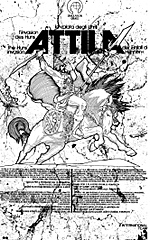 Players 2
Players 2
Playing time 5 hours
Game Period End of the Roman Empire Turn
Scale 1/2 year
Map scale 70 km/hex (probably 30 km)
Unit scale unknown
Components
1 cardboard box (35x50 cm) 1 mounted 5-piece puzzle mapboard (68x97 cm)
1 18-page rulebook in four languages
1 8-page book of examples
6 Combat cards
6 Diplomatic cards
212 Counters
Counter Manifest
Eastern Romans
- 3 Leaders (Theodosius II, Martianus, Aetius Dux)
18 Combat units Western Romans
3 Leaders (Leo I, Valentinianus III, Aegidius)
14 Combat units
Barbarians
- 8 Gepids (yellow)
8 Herules (dark blue)
8 Langobardes (dark grey)
6 Ostrogothes (pink)
8 Thuringians (dark blue)
6 Burgundians (violet)
7 Franks (red)
1 Leader (Merovaeus rex)
4 Visigoths (orange)
1 Leader (Theodoricus rex)
32 Huns (green)
3 Hun Leaders (Attila, Onegesies Dux, Orestes Dux)
Markers
- 46 Reduction of Power (12x1, 9x2, 8x3, 6x4, 6x5, 3x6, 2x7)
24 Temporary Devastation
12 Permanent Devastation
Counter size
Combat units 12 x 12 mm
Reduction of Power 12 x 6 mm
Devastation 12 x 8 mm
Note
International Team creates some problems for collectors. There is no designer, no year of production and no information about editions publicized. Thus it goes for Attila, although I think it was first produced in 1981 or 1982. The rules are in Italian, French, English and German (the German rules were translated by someone without any wargaming experience).
What IT says:
“Attila is a historical-theoretical simulation game based on the struggles between Barbarians, Romans and Romanized (Federated) taking place during the mid-fifth century A.D. By the term historical-theoretical it is meant here that in the course of the game, along with the situations that reflect the factual reality of history, some simulations of possible but undocumented situations of the period reproduced will be included.”
What the Reviewers say:
There are no reviews of the game.
Player’s Value
Attila is a game about the invasion of the Roman Empire during 445 to 452. One player is the Huns and allies, the other is the Romans. The task of the Huns is to control a number of cities after 16 turns (8 years) of play. Each city has a Victory Point value. The Barbarian player needs 20 points to win (Constantinople and Rome are worth 10 points each).
Play mechanics are easy, I go you go. Combat is fought with a standard combat ratio system and, in addition, three combat cards that alter the results (attacker: linear attack, direct charge, multiple charge; defender: linear defence, direct defence, diversive manoeuvre). This replaces dice rolling during combat. To conquer cities the attacker has to destroy the six cultivated fields around each city to reduce the defence bonus.
There are a lot of additional rules, such as Pope Leo convincing the Visigoths, Franks and Burgundians to fight against the Huns; Attila killing Leo and becoming Pope; and many more humorous but ahistorical rules.
How to play: Not funny. Long play. The barbarian hordes may move 3 to 4 hexes per turn ( 1/2 year mind you). Thus they need one year to move from Ravenna to Rome -- not very historical. The combat system is interesting -- the combination of combat odds and combat cards has its good elements. The additional rules are funny but there are a lot of other games about this period which are better.
Collector’s Value
Boone does not have any prices for this game.
Other games of this period
Attila the Hun (SSG); Rise and Fall (EMS); Barbarian, Kingdom & Empire (Icarus); Attila Scourge O’God (XTR); Die Schlacht auf den Katalaunischen Feldern (CFS); The Fall of Rome (SPI); Decline and Fall of the Roman Empire (Ariel); & Barbarians (Yaquinto).
Back to Simulacrum Vol. 3 No. 3 Table of Contents
Back to Simulacrum List of Issues
Back to MagWeb Master Magazine List
© Copyright 2001 by Steambubble Graphics
This article appears in MagWeb (Magazine Web) on the Internet World Wide Web. Other military history articles and gaming articles are available at http://www.magweb.com